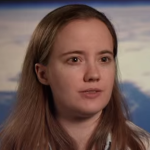In this video, astronomers describe how they developed a supercomputer model of exoplanet solar systems.
A new NASA supercomputer simulation of the planet and debris disk around the nearby star Beta Pictoris reveals that the planet’s motion drives spiral waves throughout the disk, a phenomenon that greatly increases collisions among the orbiting debris. Patterns in the collisions and the resulting dust appear to account for many observed features that previous research has been unable to fully explain. Astronomers Erika Nesvold (UMBC) and Marc Kuchner (NASA Goddard) essentially created a virtual Beta Pictoris in the computer and watched it evolve over millions of years. It is the first full 3-D model of a debris disk where scientists can watch the development of asymmetric features formed by planets, like warps and eccentric rings, and also track collisions among the particles at the same time.





